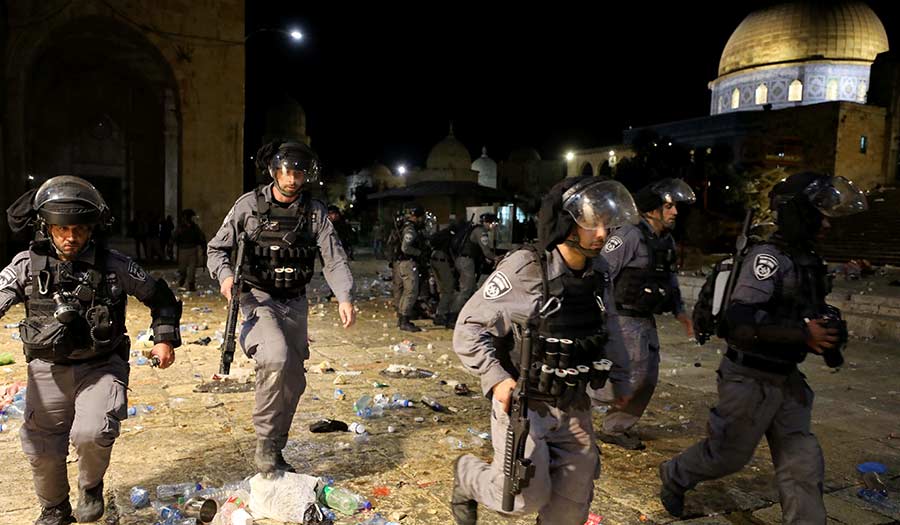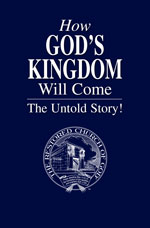 Reuters/Ammar Awad
Reuters/Ammar Awad
Article
Learn the why behind the headlines.
Subscribe to the Real Truth for FREE news and analysis.
Subscribe NowWar number four. That is how many times Israel and Gaza’s Hamas rulers have clashed in bloody conflict. In May, the Islamic militant group fired more than 4,000 rockets at Israel, some hitting deeper in Israeli territory and with greater accuracy than ever before. The onslaught was matched with hundreds of airstrikes that Israel said targeted Hamas’ infrastructure, including a vast tunnel network.
Then came the cease-fire. After 11 days of fighting, Israel and Hamas agreed to a “mutual and unconditional” truce as brokered by mediator Egypt. If this sounds all-too-familiar, it is because something similar happened in 2014, 2012 and 2008—with clashes between Israel and Hamas going back to the Islamic group’s creation in 1987.
The current round of fighting began May 10, when the militant group fired long-range rockets toward Jerusalem after days of clashes between Palestinian protesters and Israeli police at the Al-Aqsa Mosque compound, a flashpoint site sacred to Jews and Muslims.
To the Jews, Jerusalem was the capital in Old Testament times. And Christians see the city as the birthplace of the New Testament church—with some also viewing it as the prophetic epicenter of events to occur surrounding Jesus Christ’s Return.
Ideological and religious views aside, as with any war, the human cost for the Israel-Hamas conflict is tragic. The Gaza Health Ministry reported at least 250 Palestinians have been killed, including 66 children and 39 women, with 1,948 people wounded. The ministry does not break the numbers down into fighters and civilians. Hamas and militant group Islamic Jihad say at least 80 of their fighters were killed, while Israel says the number is at least 130. Some 58,000 Palestinians have fled their homes.
Yet the cease-fire does not address the fundamental issues in the Israeli-Palestinian conflict. Instead, it merely hits pause on what seems a never-ending war.
Jerusalem has been the scene of violent confrontations between Jews and Arabs for 100 years and remains one of the most bitterly contested cities on Earth.
Why does Jerusalem always seem to be on edge? Why can the city not secure true peace?
Capital of Two Peoples
Israel views Jerusalem as its “unified, eternal” capital. It captured east Jerusalem, which includes the Old City, in the 1967 Mideast war, along with the West Bank and Gaza. Palestinians want those territories for a future state, with east Jerusalem serving as their eventual capital. Many in the international community refuse to recognize Israel’s annexation of the area.
The fate of east Jerusalem has been one of the thorniest issues in the peace process, which ground to a halt more than a decade ago.
Israelis on May 10 were set to mark Jerusalem Day, a national holiday celebrating the annexation. In past years, thousands of Israelis—mainly religious nationalists—have marched through the Old City, including the densely populated Muslim Quarter, in a display considered provocative by many Palestinians.
May 10’s clashes took place in and around the Al-Aqsa Mosque in the Old City. The mosque is the third-holiest site in Islam and sits on a sprawling plateau that is also home to the iconic golden Dome of the Rock. Muslims refer to the compound as the Noble Sanctuary.
The walled plateau is also the holiest site for Jews, who refer to it as the Temple Mount, because it was the location of biblical temples. Romans destroyed the Second Temple in AD 70, with only the Western Wall remaining. The mosques were built centuries later and the site has been under Muslim care for 1,300 years.
Neighboring Jordan serves as the custodian of the site, which is operated by an Islamic endowment known as the Waqf. The site is open to tourists during certain times but only Muslims are allowed to pray there. The Western Wall is the holiest site where Jews can pray.
In recent years, groups of religious and nationalist Jews escorted by police have been visiting the compound in greater numbers and holding prayers in defiance of rules established after 1967 by Israel, Jordan and Muslim religious authorities. The Palestinians view the frequent visits and attempted prayers by Jews as a provocation, and it often ignites scuffles or more serious violence.
Some Israelis say the site should be open to all worshippers. The Palestinians refuse, fearing that Israel will eventually take over the site or partition it. Israeli officials say they have no intention of changing the status quo.
Ancient History
Clashes atop the mount are nothing new. It is easily the most coveted archeological, religious, historical and cultural plot of ground in the world. Even more, it is the epicenter of conflict in the Mideast.
Christianity and Judaism claim the site is Mount Moriah, the location of Solomon’s Temple. Muslims say it is where the prophet Muhammad took his night journey to heaven on his horse to receive the mandate to pray five times per day. Christian heritage also connects to the mount, which carried the footprints of Jesus Christ and the apostles. In addition, it was a site of Catholic cathedrals during the Crusades.
BBC broadcast journalist Tim Franks put it this way: “If Jerusalem is the crucible of the Middle East Conflict, then the Old City is the crucible of the crucible, and the [Temple Mount] is the crucible of the crucible of the crucible.”
The Temple Mount turf war reaches even further into the past. The land, which rises 2,428 feet above sea level between the Kidron and Tyropoeon valleys, has passed through the hands of great civilizations and empires.
Yet it all started with the biblical patriarch Abraham. The first recorded mention of Mount Moriah comes from the book of Genesis. After rescuing his nephew Lot from four Canaanite kings, Abraham met with King Melchizedek at the base of the mount.
Jewish scholar Doctor Benjamin Mazar placed the meeting between Abram and Melchizedek—known as “king of Salem”—in the En-Rogel valley (The Illustrated History of the Jews). Note that Salem was later renamed Jerusalem.
In his book Moriah, Andrew J. Gregg described the location of the valley: “From En-Rogel, the view of Mt. Moriah is grand, as it towers above the valley.”
After a meal, Melchizedek blessed Abraham (Gen. 14:19-20).
That night, the patriarch was blessed further: “The word of the Lord came to Abram…and He brought him forth abroad, and said, Look now toward heaven, and tell the stars, if you be able to number them: and He said unto him, So shall your seed be” (15:1-5).
The Hebrew word for abroad means “brought outside,” likely to the peak of Mount Moriah to look at the stars. Abraham then built an altar there and offered a sacrifice.
Later, the patriarch returned to the same spot after God commanded Abraham to sacrifice his son. “And they came to the place which God had told him of; and Abraham built an altar there, and laid the wood in order, and bound Isaac his son, and laid him on the altar upon the wood” (22:9).
God spared Isaac and blessed Abraham for his faithfulness.
Divided Family
Abraham’s ties to Moriah do not end there. He had two sons: first, Ishmael (by Hagar, a handmaid), then Isaac (by his wife, Sarah).
Though Abraham passed the birthright to Isaac instead of his firstborn, Ishmael was also blessed. His offspring became the Arab people. Ishmael’s 12 sons (Gen. 25:16) went on to form major Arab nations, not insignificant nomadic tribes as some believe. These peoples intermarried primarily with the Egyptians and were located southeast of Canaan, in the region of Arabia.
Isaac’s wife, Rebekah, had twins: Esau was the eldest and Jacob the younger. Esau lost the birthright—instead, it went to Jacob.
Esau married Mahalath, the daughter of Ishmael (28:9). The house of Esau, also known as the Edomites and Amalekites, gave rise millennia later to the Ottoman Turks, as well as the Seljuk Turks, who conquered and held most of Asia Minor, and the Caucasian Osmanli Turks, who controlled the Holy Land from AD 1070 until they surrendered it to the British in 1917.
Both Ishmael and Esau remained bitter for not getting the birthright blessing. The jilted brothers jealously despised the descendants of Jacob (whom God renamed Israel).
How Will It End?
Stop and consider. The world’s greatest politicians and thinkers have not found the answer to ending Israel-Palestine violence. And this is not for lack of trying. Why?
Consider this question on a larger scale. Why has mankind never been able to bring lasting peace throughout history? A major answer is human nature gets in the way.
Recall that both Muslims and Jews both claim a lineage from the patriarch Abraham. Both claims are correct! But here is what Abraham’s God says about mankind in His Word: “…the way of man is not in himself: it is not in man that walks to direct his steps” (Jer. 10:23).
Isaiah 59:8 more bluntly states: “The way of peace they know not…”
It is not given to man to figure out peace on his own. Yet this does not mean Israel and Palestine will be at war forever. The Bible also has a lot to say about Jerusalem—including how the tensions there will finally end.
One-third of Scripture is prophecy, which can be likened to history written in advance. God declares He will do something and then brings it to pass.
Peace in Jerusalem is one of the events prophesied to occur—yet it will not come by the hands of men. Notice Isaiah 40: “Comfort you, comfort you My people, says your God. Speak you comfortably to Jerusalem, and cry unto her, that her warfare is accomplished…” (vs. 1-2).
There has never been a time when Jerusalem’s warfare has ceased. The city has been in the hands of Jews, Muslims, Christians and others throughout millennia. The Old Testament shows that ancient Israel fared little better than its modern counterparts.
Jerusalem’s warfare ending is just one element of what God will soon do on Earth. It is one piece of Him setting up a Kingdom that will never be destroyed (Dan. 2:44)—bringing peace to the Middle East and the entire globe.
Read How God’s Kingdom Will Come – The Untold Story! for the full picture.
This article contains information from The Associated Press.
More on Related Topics:
- Gaza Is in Ruins, and It Is Unclear How It Will Be Rebuilt
- After Economic Meltdown and War with Israel, Lebanon’s New Prime Minister Vows to Rebuild
- IAEA Chief: Iran Is Poised to ‘Quite Dramatically’ Increase Stockpile of Near Weapons-grade Uranium
- What Is Blocking a Ceasefire Between Israel and Hezbollah?
- UN Nuclear Agency’s Board Condemns Iran for the 2nd Time This Year for Failing to Fully Cooperate



